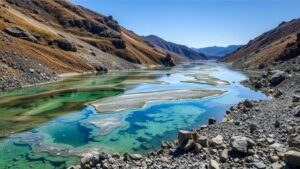Recovering Precious Metals From Weathered Volcanic Rock Formations
Recovering Precious Metals From Weathered Volcanic Rock Formations
The extraction of precious metals from weathered volcanic rock formations represents a significant intersection of geology, mining technology, and environmental stewardship. As the demand for metals such as gold, silver, and platinum continues to rise, the focus on alternative sources, including volcanic materials, becomes increasingly relevant. This article explores the methodologies for recovering these metals, the geological processes involved, and the implications for industry and ecosystem conservation.
The Geological Context of Precious Metal Recovery
Volcanic rock formations are often rich in minerals due to the diverse geological processes involved in their formation. During volcanic eruptions, magma rises to the earths surface, bringing with it a variety of metals. Over time, these rocks undergo weathering, a process that can concentrate valuable minerals. The most common volcanic rock types involved in precious metal recovery include:
- Basalt
- Pumice
- Rhyolite
These rocks, depending on their mineral composition and the conditions of weathering, can contain economically significant concentrations of precious metals. For example, altered volcanic rocks may host disseminated gold and silver particles that are otherwise difficult to identify through conventional mining methods.
Assessment and Exploration Techniques
The first step in recovering precious metals from weathered volcanic formations is geological assessment. Exploration techniques often used include:
- Geochemical analysis: This method involves sampling soil, rock, and water to identify the presence of precious metals. Portable X-ray fluorescence (XRF) analyzers are commonly utilized for rapid on-site assessments.
- Geophysical surveys: Techniques such as resistivity and magnetic surveys help map the subsurface characteristics and locate potential mineral deposits.
These exploration methods help delineate areas with a higher likelihood of containing precious metals, thereby optimizing resource allocation for extraction operations.
Extraction Methods
Once potential sites are identified, several extraction methods can be employed, primarily depending on the concentration and accessibility of the metals. Common techniques include:
- Heap Leaching: A process where crushed ore is stacked on a liner and treated with a leaching solution to dissolve the metals. This method is particularly effective in low-grade deposits.
- Gravity Separation: Using physical properties, this method separates heavier precious metal particles from lighter materials through processes such as panning or shaking tables.
- Flotation: Involves adding chemicals to a slurry of crushed volcanic rock, which causes certain minerals to become hydrophobic and attach to bubbles, allowing for separation.
Each of these methods has its advantages and disadvantages, notably in terms of cost, environmental impact, and efficiency. For example, heap leaching is simpler and less capital-intensive but can raise concerns regarding chemical runoff and soil contamination.
Environmental Considerations
The recovery of precious metals from volcanic rocks can raise significant environmental concerns. potential for soil contamination, water pollution, and habitat destruction necessitates careful management and regulation. The use of eco-friendly extraction methods is on the rise, including:
- Biotechnological approaches: Utilizing microorganisms to bioleach metals from ores represents an innovative and less harmful method.
- Reclamation practices: This involves restoring landscapes after mining operations to prevent habitat loss and ecosystem degradation.
Useing these practices not only mitigates environmental impact but also enhances public perception and compliance with regulations.
Case Studies
Several real-world examples illustrate the successful recovery of precious metals from weathered volcanic formations:
- Gold Recovery in Chile: Chilean mining firms have employed heap leaching in weathered volcanic tuffs, resulting in a significant increase in gold production without extensive land disturbance.
- Platinum Group Metals in Iceland: Research in Iceland has indicated that volcanic soils enriched with certain minerals have been effective in recovering platinum group metals through gravity separation techniques.
Actionable Takeaways
To wrap up, the recovery of precious metals from weathered volcanic rock formations presents both opportunities and challenges. Stakeholders in the mining and environmental sectors must:
- Invest in advanced exploration techniques to optimize metal recovery.
- Use environmentally responsible extraction methods to minimize ecological impacts.
- Stay informed on regulatory changes and technological advancements to enhance operational efficiency.
Continued research and innovative practices will be key in ensuring that precious metal recovery contributes positively to the economy while safeguarding the environment.



